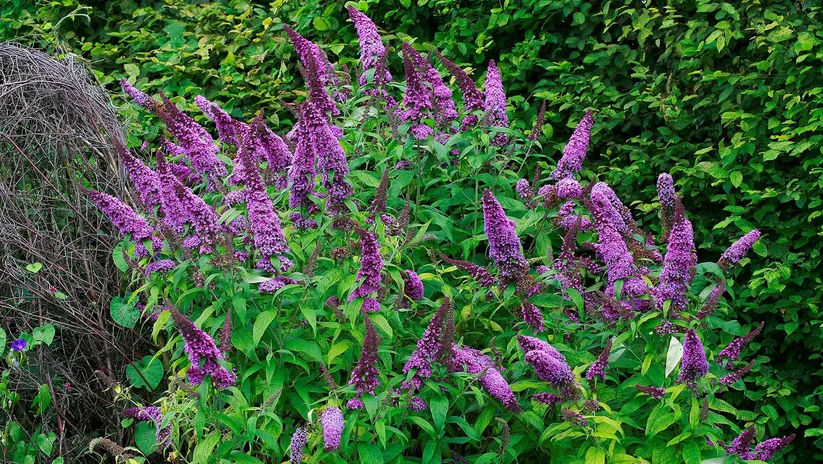
The Butterfly Bush, botanically referred to as Buddleja davidii, is a flowering plant that belongs to the family Scrophulariaceae. It is native to Sichuan and Hubei provinces in central China, and also Japan. It has been widely cultivated in other parts of the world, including North America, Europe, and Australia. The plant in many places is commonly referred as summer lilac due to its resemblance to lilac flowers.
Buddleja davidii was first discovered by the French missionary and naturalist, Pere Armand David, in 1869/1870 along the border of China and Tibet. The plant was named in his honor, with the specific epithet “davidii” being derived from his surname.
Buddleja davidii is a deciduous shrub that can grow up to 10 feet tall and 10 feet wide. It has a rounded, bushy form with arching branches and lance-shaped leaves that are usually gray-green in color. The plant produces long, cone-shaped clusters of tiny flowers that can be purple, pink, red, white, and yellow. The flowers bloom from mid-summer to early fall.
In the wild, the straight species flowers of Buddleja davidii are lilac to purple with orange-yellow throats. Over the years, numerous named cultivars have been introduced, expanding the range of flower colors to include pinks, yellows, whites, and reds.
The plant was introduced to the United Kingdom in the late 19th century and later to North America. It was initially grown as an ornamental plant in gardens due to its attractive flowers and ability to attract butterflies and other pollinators. However, it was later discovered that the plant had the potential to become invasive in some regions.
Buddleja davidii has been designated as an invasive species or a “noxious weed” in a number of countries in temperate regions, including the United Kingdom, the Republic of Ireland and New Zealand. It is naturalized in Australia and in many cities of central and southern Europe, where it can spread on open lands and in gardens.
Buddleja davidii is also considered an invasive species in many parts of the United States, particularly in the Pacific Northwest, where it has been known to displace native vegetation and disrupt ecosystems. As a result, many states have taken steps to control the spread of the plant, including banning its sale and encouraging the removal of existing plants.
In cultivation, Butterfly bushes are easy to grow and care for, and they can thrive in many soil types and conditions. They usually love full sun and well-drained soil, but they can also tolerate some shade and poor soil. The plants are drought-tolerant once established, but they will benefit from regular watering during dry spells.
Butterfly bushes can be propagated by taking softwood cuttings in early summer or by sowing seeds in the spring. The plants can also be pruned to control their size and shape, and to encourage more vigorous growth and flowering.
These shrubs can be used for butterfly gardens, mixed borders, and informal hedges. They can also be grown in containers for patio or balcony gardens. The plant is attractive to butterflies and other insects like monarchs, swallowtails, and painted ladies, as well as bees and hummingbirds.
Characteristics of Butterfly Bush (Buddleja davidii)
- Size: 6-12 feet tall and 4-15 feet wide
- Growth rate: Fast-growing
- Growth habit: Deciduous shrub
- Branches: Arching and spreading
- Flowers: Cone-shaped clusters of tiny flowers, ranging in color from purple to pink, red, white, and yellow
- USDA zones: 5 to 9
- Lifespan: Perennial
- Root system: Deep and extensive
- When to grow: Plant in spring or fall
- Where to grow: Full sun, well-drained soil
Cultivars of Butterfly Bush (Buddleja Davidii)
| Name | Short Description | Flower | Size |
| ‘Black Knight’ | Dark purple flowers on long, arching panicles; highly fragrant. | Dark Purple | 6-10 feet tall |
| ‘White Profusion’ | Profuse clusters of pure white flowers; attracts butterflies and bees. | White | 5-8 feet tall |
| ‘Royal Red’ | Deep red-purple flowers with orange throats; attracts butterflies and hummingbirds. | Red-Purple | 6-8 feet tall |
| ‘Pink Delight’ | Soft pink flower clusters with orange eyes; sweetly scented; attracts butterflies. | Pink | 5-7 feet tall |
| ‘Miss Ruby’ | Compact habit with magenta-pink flower spikes; attracts butterflies and hummingbirds. | Magenta-Pink | 3-5 feet tall |
| ‘Nanho Purple’ | Dwarf variety with lavender-purple flower spikes; fragrant; suitable for smaller gardens. | Lavender-Purple | 3-4 feet tall |
| ‘Lochinch’ | Large clusters of lilac-blue flowers; silvery-gray foliage; attracts butterflies and bees. | Lilac-Blue | 6-8 feet tall |
| ‘Blue Chip’ | Compact, dwarf variety with true blue flower spikes; sterile; attracts butterflies and bees. | Blue | 2-3 feet tall |
| ‘Harlequin’ | Variegated foliage with purple-pink flower spikes; adds interest even when not in bloom. | Purple-Pink | 5-7 feet tall |
| ‘Santana’ | Burgundy-red flowers with orange eyes; variegated foliage with creamy-yellow margins. | Burgundy-Red | 6-8 feet tall |
| ‘Buzz™ Sky Blue’ | Compact habit with sky-blue flower spikes; sterile; attracts butterflies and bees. | Sky Blue | 3-4 feet tall |
| ‘Miss Violet’ | Rich violet-purple flowers on compact, upright stems; fragrant; attracts butterflies. | Violet-Purple | 4-6 feet tall |
| ‘Flutterby Petite® Blue’ | Dwarf variety with sky-blue flower spikes; compact and sterile; suitable for containers. | Sky Blue | 2-3 feet tall |
| ‘Summer Beauty’ | Lavender-pink flowers on arching branches; fragrant; attracts butterflies and hummingbirds. | Lavender-Pink | 6-8 feet tall |
| ‘Royal Red’ | Large, vibrant red flower spikes; attracts butterflies and hummingbirds; fragrant. | Red | 6-8 feet tall |